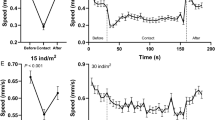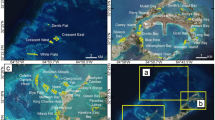Abstract
Defensive aggregation by Strongylocentrotus droebachiensis has been invoked as the fulcrum for the transformation of macroalgal beds into coralline barrens in the northwest Atlantic. We critically examined some of the mechanisms contributing to aggregation behavior by experimentally manipulating sea urchins, purported predators and food during autumn 1983 and spring 1984 both in the laboratory and field. We utilized several approaches to examine a range of sea urchin responses to the presence of food, tethered predators, caged predators, crushed con-specifics in the field and predators in laboratory tanks. Some of the field cages had the property of allowing free passage to sea urchins while retaining lobsters; this allowed distinctions to be made between artifacts caused by cage walls or topographic barriers and unrestricted behavioral responses of sea urchins. The results falsified the hypothesis that aggregations of S. droebachiensis are elicited by predators. Except in the presence of algae, sea urchins always avoided decapod predators (but not sea stars) and fled from the vicinity of injured conspecifics. However, avoidance behavior was subordinate to feeding responses, demonstrated by mass migrations of sea urchins into cages (with lobsters) to feed on algae. We reaffirmed by observation and manipulation previous studies which showed that sea urchins aggregate only in the presence of food. Two types of sea urchin groupings were delineated: (1) surficial two dimensional associations, often caused by topographic or other features which inhibited dispersal and (2) cohesive three-dimensional aggregations induced by food.
Similar content being viewed by others
Literature cited
Bak, H. P. and S. Nojima: Immigration of a tropical sea urchin, Astropyga radiata (Leske), in a temperate eelgrass. Zostera marina L., patch: its feeding habit and grazing effect on the patch. Publ. Amakusa mar. biol. Lab., Kyushu Univ. 5, 153–169 (1980)
Bernstein, B. B. and K. H. Mann: Changes in the nearshore ecosystem of the Atlantic coast of Nova Scotia, 1968–81. NAFO Sci. Coun. Studies 5, 101–105 (1982)
Bernstein, B. B., S. C. Schroeter and K. H. Mann: Sea urchin (Strongylocentrotus droebachiensis) aggregating behavior investigated by a subtidal multifactorial experiment. Can. J. Fish. aquat. Sci. 40, 1975–1986 (1983)
Bernstein, B. B., B. E. Williams and K. H. Mann: The role of behavioral responses to predators in modifying urchin's (Strongylocentrotus droebachiensis) destructive grazing and seasonal foraging patterns. Mar. Biol. 63, 39–49 (1981)
Breen, P. A. and K. H. Mann: Destructive grazing of kelp by sea urchins in Eastern Canada. J. Fish. Res. Bd Can. 33, 1278–1283 (1976a)
Breen, P. A. and K. H. Mann: Changing lobster abundance and the destruction of kelp beds by sea urchins. Mar. Biol. 34, 137–142 (1976b)
Camp, D. K., S. P. Cobb and J. F. van Breedveld: Overgrazing of seagrasses by a regular urchin, Lytechinus variegatus. Bioscience 23, 37–38 (1973)
Carter, J. A. and D. H. Steele: Stomach contents of immature lobsters (Homarus americanus) from Placentia Bay, Newfoundland. Can. J. Zool, 60, 337–347 (1982)
Chapman, A. R. O.: Stability of sea urchin dominated barren grounds following destructive grazing of kelp in St. Margaret's Bay, Eastern Canada. Mar. Biol. 62, 307–311 (1981)
Connell, J. H.: Ecology, field experiments in marine ecology. In: Experimental marine biology, pp 21–54. Ed. by R. N. Mariscal. New York: Academic Press 1974
Dayton, P. K.: Competition, disturbance, and community organization: The provision and subsequent utilization of space in a rocky intertidal community. Ecol. Monogr. 41, 351–389 (1971)
Dayton, P. K. and J. S. Oliver: An evaluation of experimental analyses of population and community patterns in benthic marine environments. In: Marine benthic dynamics, pp 93–120. Ed. by K. Tenore and B. C. Coull: Belle W. Baruch Library of Marine Science Pub. 11. Columbia: University of South Carolina Press: 1980
Dean, T. A., S. C. Schroeter and J. D. Dixon: Effects of grazing by two species of sea urchins (Strongylocentrotus franciscanus and Lytechinus anamesus) on recruitment and survival of two species of kelp (Macrocystis pyrifera and Pterygophora californica). Mar. Biol. 78, 301–313 (1984)
Ebert, T. A.: Growth rates of the sea urchin Strongylocentrotus purpuratus related to food availability and spine abrasion. Ecology 49, 1075–1091 (1968)
Elner, R. W.: Predation on the sea urchin (Strongylocentrotus droebachiensis) by the American lobster (Homarus americanus) and the rock crab (Cancer irroratus). In: Proceedings of the workshop on the relationship between sea urchin grazing and commercial plant/animal harvesting, pp 48–65. Ed. by J. D. Pringle, G. J. Sharp and J. F. Caddy, Halifax: Can. Techn. Rep. Fish. aquat. Sci. 954, 1980
Ennis, G. P.: Food, feeding, and condition of lobsters, Homarus americanus, throughout the seasonal cycle in Bonavista Bay, Newfoundland. J. Fish. Res. Bd Can. 30, 1905–1909 (1973)
Evans, P. D. and K. H. Mann: Selection of prey by American lobsters (Homarus americanus) when offered a choice between sea urchins and crabs. J. Fish. Res. Bd Can. 34, 2203–2207 (1977)
Garnick, E.: Behavioral ecology of Strongylocentrotus droebachiensis (Muller) (Echinodermata, Echinoidea), aggregating behavior and chemotaxis. Oecologia 37, 77–84 (1978)
Grant, W. S. and R. L. Vadas: Feeding behavior and reproductive cycles in a northern population of the sea star, Asterias forbesi. Bull. Ecol. Soc. Amer. 54, 34 (1973)
Hagen, N. T.: Destructive grazing of kelp beds by sea urchins in Vestfjorden, northern Norway. Sarsia 68, 177–190 (1983)
Himmelman, J. H. and D. H. Steele: Food and predators of the green sea urchin Strongylocentrotus droebachiensis in Newfoundland waters. Mar. Biol. 9, 315–322 (1971)
Hooper, R.: Observations on algal-grazer interactions in Newfoundland and Labrador. In: Proceedings of the workshop on the relationship between sea urchin grazing and commercial plant/animal harvesting, pp 120–124. Ed. by J. D. Pringle, G. J. Sharp and J. F. Caddy. Halifax: Can. Techn. Rep. Fish. aquat. Sci. 954, 1980
Larson, B. R., R. L. Vadas and M. Keser: Feeding and nutritional ecology of the sea urchin Strongylocentrotus droebachiensis in Maine, USA. Mar. Biol. 59, 49–62 (1980)
Lawrence, J. M.: On the relationship between marine plants and sea urchins. Ann. Rev. Oceanogr. mar. Biol. 13, 213–286 (1975)
Leighton, D. L.: Studies of food preference in algivorous invertebrates of S. California kelp beds. Pac. Sci. 20, 104–113 (1966)
Leighton, D. L.: Grazing activities of benthic invertebrates in Southern California kelp beds. Nova Hedwigia 32, 421–453 (1971)
Mann, K. H.: Destruction of kelp beds by sea urchins: a cyclical phenomenon or irreversible degradation? Helgoländer. wiss. Meeresunters. 30, 455–467 (1977)
Mann, K. H.: Kelp, sea urchins and predators, a review of strong interactions in rocky subtidal systems of eastern Canada, 1970–1980. Neth. J. Sea Res. 16, 414–423 (1982)
Mann, K. H. and P. A. Breen: The relation between lobster abundance, sea urchins and kelp beds. J. Fish. Res. Bd Can. 29, 603–605 (1972)
Mann, K. H., J. L. C. Wright, B. E. Welsford and E. Hatfield: Responses of the sea urchin Strongylocentrotus droebachiensis (O. F. Muller) to water-borne stimuli from potential predators and potential food algae. J. exp. mar. Biol. Ecol. 79, 233–244 (1984)
Mattison, J. E., J. D. Trent, A. L. Shanks, T. B. Akin and J. S. Pearse: Movement and feeding activity of red sea urchins (Strongylocentrotus franciscanus) adjacent to a kelp forest. Mar. Biol. 39, 25–30 (1977)
Mauzey, K. P., C. Birkeland and P. K. Dayton: Feeding behavior of asteroids and escape responses of their prey in the Puget Sound region. Ecology 49, 603–619 (1968)
Miller, R. J.: Succession in sea urchin and seaweed abundance in Nova Scotia, Canada. Mar. Biol. 84, 275–286 (1985)
Miller, R. J. and A. G. Colodey: Widespread mass mortalities of the green sea urchin in Nova Scotia, Canada. Mar. Biol. 73, 263–267 (1983)
Miller, R. J. and K. H. Mann: Ecological energetics of the seaweed zone in a marine bay on the Atlantic coast of Canada III. Energy transformations by sea urchins. Mar. Biol. 18, 99–114 (1973)
Moitoza, D. J. and D. W. Phillips: Prey defense, predator preference, and non-random diet: the interactions between Pycnopodia helianthoides and two species of sea urchins. Mar. Biol. 52, 299–304 (1979)
North, W. J.: Kelp habitat improvement project, final report. Univ. Cal. Inst. Mar. Res., IMR 63-13. 123 pp. 1963
North, W. J. and J. S. Pearse: Sea urchin population explosion in Southern California coastal waters. Science, N. Y. 167, 209–210 (1970)
North, W. J. and M. B. Schaefer: An investigation of the effects of discharged wastes on kelp. Calif. Water Control Bd Pub. No. 26, 121 pp. 1964
Ogden, J. C., R. A. Brown and N. Salesky: Grazing by the echinoid Diadema antillarum Phillippi, formation of halos around West Indian patch reefs. Science, N.Y. 182, 715–717 (1973)
Paine, R. T.: A note on trophic complexity and community stability. Am. Nat. 103, 91–93 (1969)
Pain, R. T. and R. L. Vadas: The effects of grazing by sea urchins, Strongylocentrotus spp., on benthic algal populations. Lomnol. Oceanogr. 14, 710–719 (1969)
Pearse, J. S. and S. W. Arch: The aggregation behavior of Diadema (Echinodermata, Echinoidea). Micronesia 5, 165–171 (1969)
Pearse, J. S. and A. H. Hines: Expansion of a central California kelp forest following the mass mortality of sea urchins. Mar. Biol. 51, 83–91 (1979)
Pringle, J. D., G. J. Sharp and J. F. Caddy: An update on the relationship between commercial lobstering and urchin and macroalgal densities. In: Proceedings of the workshop on the relationship between sea urchin grazing and commercial plant/animal harvesting, pp 237–251. Ed. by J. D. Pringle, G. J. Sharp and J. F. Caddy. Halifax: Can. Tech. Rep. Fish. aquat. Sci. 954, 1980
Pringle, J. D., G. J. Sharp and J. F. Caddy: Interactions in kelp bed ecosystems in the northwest Atlantic, review of a workshop. Can. Special Publ. Fish. aquat. Sci. 59, 169 pp. 1982
Randall, J. E.: Grazing effect on seagrasses by herbivorous reef fishes in the West Indies. Ecology 46, 255–260 (1965)
Russo, A. R.: Dispersion and food differences between two populations of the sea urchin Strongylocentrotus franciscanus. J. Biogeog. 6, 407–414 (1979)
Simberloff, D.: A succession of paradigms in ecology: essentialism to materialism and probabilism. Synthese 43, 3–39 (1980)
Snyder, N. and H. Snyder: Alarm response of Diadema antillarum. Science, N.Y. 168, 276–278 (1970)
Squires, H. J.: Lobster (Homarus americanus) fishery and ecology in Port au Port Bay, Newfoundland, 1960–65. Proc. natl Shellfish Assoc. 60, 22–39 (1970)
Strong, D. R., Jr.: Null hypotheses in ecology. Synthese 43, 271–285 (1980)
Strong, D. R., Jr.: Natural variability and the manifold mechanisms of ecological communities. Am. Nat. 122, 636–660 (1983)
Tegner, M. J. and L. A. Levin: Spiny lobsters and sea urchins: analysis of a predator-prey interaction. J. exp. mar. Biol. Ecol. 73, 125–150 (1983)
Thomas, M. L. H.: Marine and coastal systems of the Quoddy region, New Brunswick. Can. Special Publ. Fish. aquat. Sci. 64, 306 pp. Ottawa: DFO 1983
Vadas, R. L.: The ecology of Agarum and the kelp bed community. Ph. D. thesis, University of Washingtom, Seattle, WA. 280 pp. 1968
Vadas, R. L.: Preferential feeding, an optimization strategy in sea urchins. Ecol. Monogr. 47, 337–371 (1977)
Vance, R. R. and R. J. Schmitt: The effect of the predator-avoidance behavior of the sea urchin (Centrostephanus coronatus), on the breadth of its diet. Oecologia 44, 21–25 (1979)
Warner, G. F.: Aggregation in echinoderms. In: Biology and systematics of colonial organisms, pp 375–396. Ed. by G. Larwood and B. R. Rosen, New York: Academic Press, 1979
Yendo, K.: On the cultivation of seaweeds, with special accounts of their ecology. Econ. Proc. R. Dublin Soc. 2, 105–122 (1914)
Author information
Authors and Affiliations
Additional information
Communicated by J. M. Shick, Orono
Rights and permissions
About this article
Cite this article
Vadas, R.L., Elner, R.W., Garwood, P.E. et al. Experimental evaluation of aggregation behavior in the sea urchin Strongylocentrotus droebachiensis . Mar. Biol. 90, 433–448 (1986). https://doi.org/10.1007/BF00428567
Accepted:
Issue Date:
DOI: https://doi.org/10.1007/BF00428567




